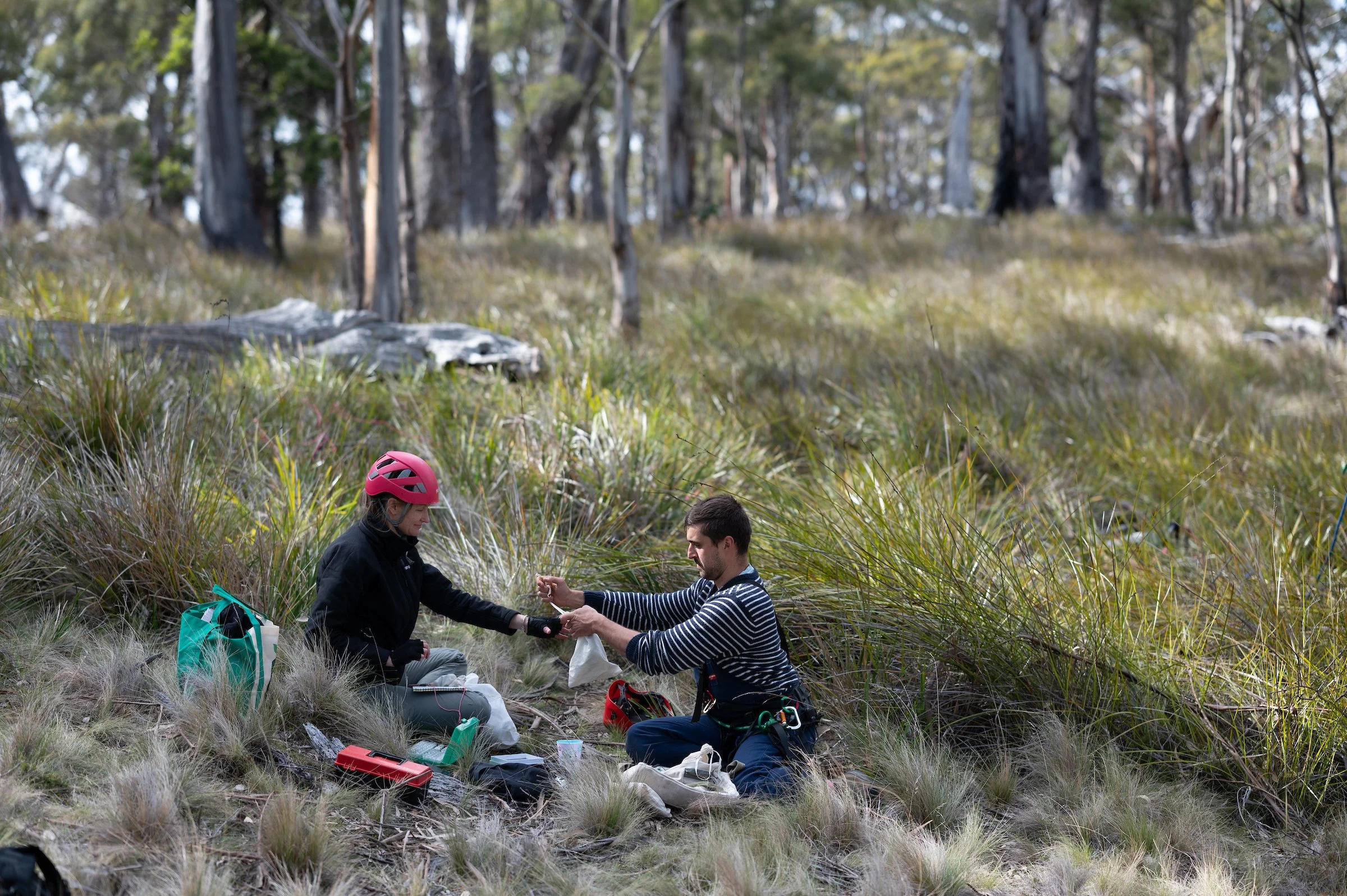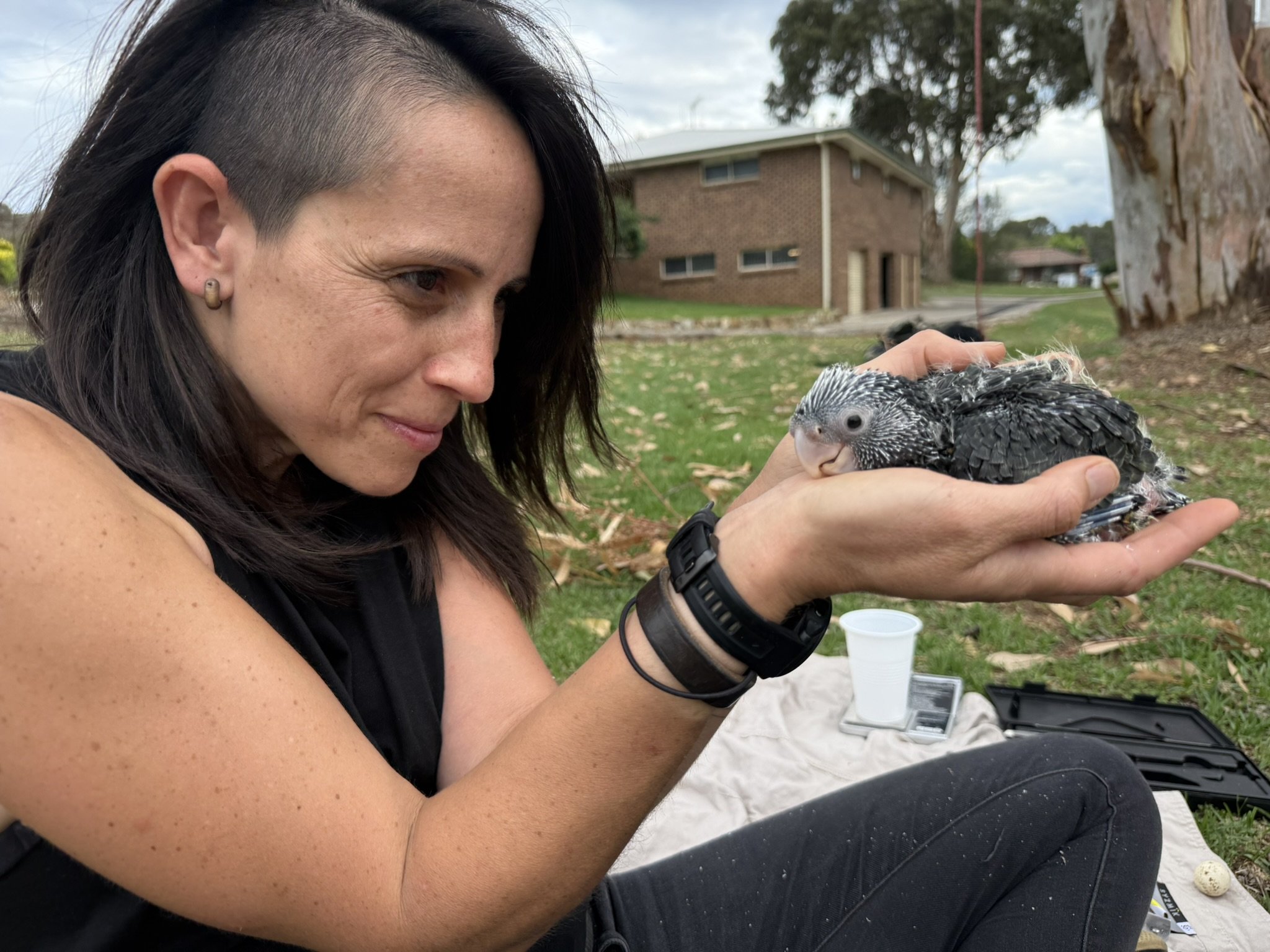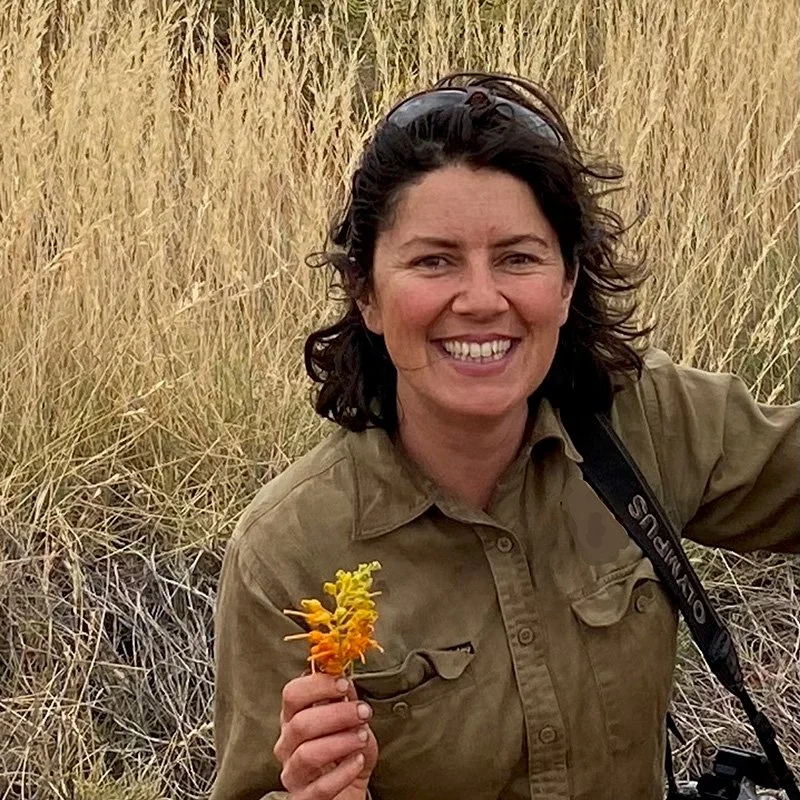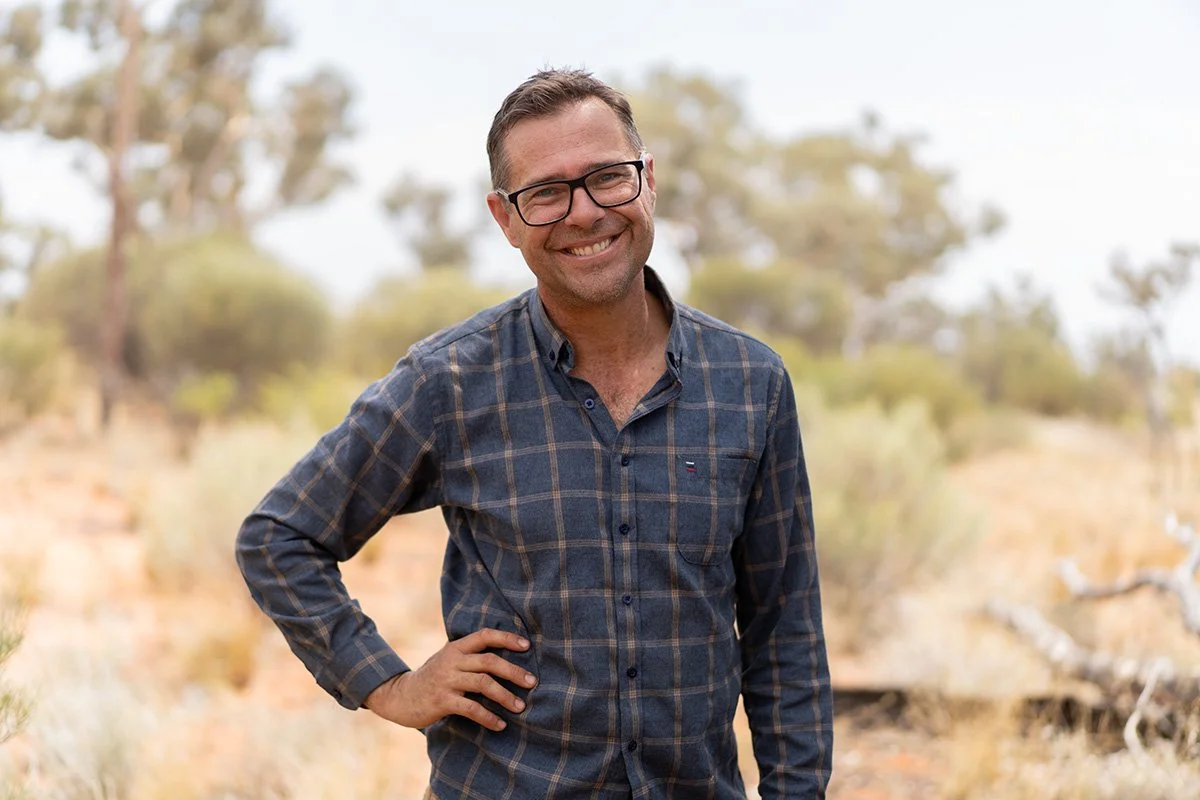Dr Dejan Stojanovic
I am the lead researcher of the DBRG, and manage a range of projects primarily in Tasmania and elsewhere around Australia. I am a conservation scientist interested in the factors that affect small and declining populations, and am responsible for managing operations of the DBRG.
I undertook my PhD research on the breeding biology of the endangered swift parrot in their Tasmanian breeding range. My research shed light on details about the breeding ecology of a species for which there were no data in spite of its severely threatened status.
Since then, I have become increasingly involved in the conservation management of a range of other threatened species. My work includes a research program on the three Polytelis parrot, orange-bellied parrots, rufous scrub birds and ongoing work on swift parrots. I supervise several staff and students on a range of species across Australia. Prospective students can contact me via email.
Dr Ross Crates
I am a postdoctoral fellow within the DBRG. While studying a BSc in Ecology at the University of East Anglia, UK, I spent a year as an exchange student at the University of Wollongong where I studied the ecology of fairywrens. After graduating, I worked as a research assistant at the Edward Grey Institute, University of Oxford, on a large scale study into the social ecology of wild songbirds using novel tracking devices. In 2015 I returned to Australia to commence my PhD into the ecology and conservation of the Regent Honeyeater.
I manage national monitoring programs for the Regent Honeyeater (breeding) and Swift Parrot (wintering). My current research topics include: 1) Reducing Noisy Miner numbers in areas of high conservation value; 2) Dynamics of Regent Honeyeater song culture, 3) Nest predators, nest depredation and nest protection, 4) Conservation genomics, 5) Estimating bushfire impacts on the Regent Honeyeater, 6) Threatened species monitoring, 7) Conservation of King Island's small brown birds
Dr Fernanda Alves de Amorim
I am a conservation biologist with an interest in population ecology and management of threatened species and their habitat. I am interested in how populations interact with the environment after landscape changes and how management interventions can help the persistence of populations. In 2014, I completed my Masters in Zoology at the University of São Paulo in Brazil. For my Masters’ research I estimated population density and investigated habitat selection by the endangered red-billed curassow (Crax blumenbachii) in one of the remaining lowland Atlantic Forest stronghold for this species.
I have been working with the DBRG since 2015, and was awarded a PhD scholarship at the Research School of Biology to conduct my research on Forty-spotted pardalotes. My research on forty spotted pardalotes focusses on their landscape scale patterns of occupancy and abundance, plus fine scale aspects of their breeding success and parasite ecology.
Dr Giselle Owens
I’m a Postdoctoral Research Fellow with the Fenner School of Environment and Society at the Australian National University. My research interests are broad, across bird ecology and conservation, with a focus on hollow-nesting species. A lot of my research has been on the critically endangered swift parrot, which I began as an honours student, continued as a research officer, and was the focus of my doctorate.
My PhD thesis was on the extrinsic factors contributing to population decline in the swift parrot’s breeding range and addressed numerous recovery plan actions along the way.
My current research focuses on using bioacoustics to monitor critically endangered orange-bellied parrots, and includes work on its Neophema relative, the vulnerable blue-winged parrot. I joined the DBRG in 2018 and enjoy working across our teams projects and species. Most of all, I am motivated to apply conservation science to fill knowledge gaps and inform effective recovery pathways for threatened species.
Tom Hunt
I'm a conservation ecologist with a broad interest in the natural world, but I’m particularly interested in the research and management of threatened birds. Originally from South Australia, I studied at The University of Adelaide and for over a decade have been involved in conservation and restoration projects across South Australia, Victoria, and New South Wales. This work has included researching threatened mallee birds and reintroducing locally extinct mammals with the Wild Deserts project.
Now based in Tasmania, I am involved with several projects in the DBRG including forty-spotted pardalotes and swift parrots, focusing on habitat assessments, threatening processes, and effective on-ground management actions. I’m driven by my passion for the Australian landscape and its wildlife, and I am proud to be part of a like-minded team working to improve conservation outcomes.
Dr George Olah
I am a conservation biologist interested in evolutionary genetics and tropical ecology. I gained my MSc degree in Applied Zoology from the University of Veterinary Sciences in Budapest, Hungary. I obtained extensive field experience on psittacines in many Latin-American countries in the Neotropics.
During my PhD at the Australian National University I became an expert in modern molecular genetics. Before and during my PhD research I worked years in the Peruvian Amazon with local communities and the eco-tourism industry. I recently produced a documentary movie about this work (www.macawmovie.com).
My interest in genetic analyses, and my endeavour to preserve biological diversity via well established conservation management, found their common niche in conservation genetics and genomics.
Dr Laura Rayner
I am a conservation ecologist studying population dynamics of species in modified landscapes. I am particularly interested in long-term monitoring for the development and evaluation of conservation interventions aimed at safeguarding threatened species and restoring temperate woodland.
Within the DBRG, I contribute to the design and implementation of the National Regent Honeyeater Monitoring Program, and coordinate the Superb Parrot Conservation Research Project.
I hold a Senior Ecologist position with the ACT Government where I focus my time gathering and interpreting applied scientific evidence to support conservation operators; including land managers, strategic planners, policy makers, recovery teams and local community groups.
Stacey Taylor
I am a PhD candidate at the ANU, focusing on addressing critical knowledge gaps in the ecology of Gang-gang Cockatoos. I am also a Senior Conservation Planner with the ACT Government, where my focus is on developing high-level strategic documents and applying ecological principles to local conservation efforts.
In previous roles I lived and worked in remote locations across Australia, facilitating collaborations between Indigenous communities, ecological researchers, and contemporary land managers.
By locating and describing critical breeding habitat, and investigating predation and competition pressure on reproductive success, I hope to inform conservation efforts for the Gang-gang Cockatoo at both a local and range-wide scale. My research also aims to describe the population genetics of Gang-gang Cockatoos across their range, including trialling non-invasive methods to collect genetic
Dr Catherine Young
I am a behavioural ecologist, interested in breeding systems and the secret lives of birds. I completed a PhD at ANU with Dr Sarah Pryke, Prof Patricia Backwell and Prof Robert Heinsohn, investigating the social system of crimson finches in the east Kimberley region of Western Australia. My research has taken me to all corners of Australia, the UK and South Africa.
I joined the DBRG in Tasmania in 2017 as an all-round research tech, helping mostly with fieldwork and data collection in Tasmania, but also working with the Canberra based crew. Outside of the DBRG I collaborate with research groups based in Tasmania, New Zealand and Sydney.
McLean Cobden
I am a PhD candidate studying superb parrots, addressing critical knowledge gaps in the species’ ecology that prevent robust assessment of conservation status and possible management action. Incorporating GPS tracking data and measures of reproductive output, I hope to identify critical breeding, foraging, and wintering sites, and maximise conservation gains from broad-scale habitat and connectivity restoration efforts.
I have a broad research interest in ecology, with a focus on using robust ecological science to inform the management of threatened species. Having completed a BSc (Hons) in environment science, and later a MSc with the DBRG, I have experience in a diverse range of systems and species. I’ve come to enjoy working on birds (in particular parrots) and continue to be motivated by the often complex and challenging questions associated with these species.
Dr Grace Hodder
I’m a Postdoctoral Research Fellow at the Fenner School of Environment and Society, with a background in field ecology and threatened species research. My ecological work has ranged from wildlife reintroduction programs to ecosystem monitoring on the Murray River floodplain.
For my PhD, I studied the ecology of a threatened woodland bird in South Australia, and my research since has focused on declining and rare avifauna. I’m passionate about science that has a direct application to conservation, and environmental outreach in all forms.
In my role with the Difficult Birds Research Group, I’m coordinating an investigation into the spatial ecology of the Vulnerable regent parrot.
Annie Kriesl
Before joining the DBRG team, I worked as a wetland ecologist in South Australia, where I was involved in monitoring and management projects for regent parrots and other wetland species.
Now based in Tasmania, I’m working as a research officer supporting several of DBRG’s projects. I’m primarily involved with blue-winged parrots and swift parrots, contributing to fieldwork and data collection.
I’m passionate about Australia’s ecology and hope to contribute to knowledge gaps that improve our understanding and help protect threatened species.
Dr Laura Bussolini
I am a Postdoctoral Research Fellow at the Fenner School of Environment and Society focusing on the conservation management of critically endangered birds. I completed my PhD with the DBRG in 2024 where I researched how captive breeding programs and can be used for species conservation actions, with a focus on the critically endangered orange-bellied parrot (Neophema chrysogaster).
I have worked professionally on a wide range of field-based conservation projects across Australia, New Zealand, and the US, and also have a strong background in captive animal husbandry and release programs.
My primary research interests centre around species conservation, especially the confluence of conservation science and management actions.
Luke Vial
I am a research officer with the Difficult Birds Research Group, currently assisting with research into the ecology of the regent parrot — a vulnerable species found along the River Murray corridor and surrounding mallee environments.
Prior to this role with DBRG, I worked as a floodplain ecologist on several key River Murray wetlands, where I was involved in monitoring programs and environmental water management to support ecological outcomes. I also spent time in Timor-Leste designing and implementing ecological monitoring programs in degraded upland landscapes, with a focus on biodiversity outcomes.
With a strong passion for bird conservation and broader threatened species recovery, I‘m interested in how ecological research can inform effective management strategies. I’m excited to be working on regent parrots in a region I already know well, contributing to research that directly informs their recovery.
Dr Ellen Ryan-Colton
I have worked for over 16 years in semi-arid and arid zone ecology, protected area management and landscape-scale threats. I completed my PhD on a major threat to the arid zone, the invasion of buffel grass, looking at the impact on flora and fauna communities and ecosystems processes. I am currently a senior research officer with DBRG working on building a two-way foundation for studying Princess Parrots in central Australia. With my work, I am to elevate Indigenous and local knowledge, two-way science and sound ecological monitoring and data analysis to support better management of Country including of threatened species and broad-scale threats. I am a fellow of the Intergovernmental Science-Policy Platform on Biodiversity and Ecosystem Services (IPBES) including the IPBES Indigenous Local Knowledge liaison group.
Dr Daniel Gautschi
I am a Postdoctoral Research Fellow at the Fenner School of Environment and Society, with a current research focus on the population genetics of highly-mobile parrots. I finished my PhD with the DBRG in 2024, in which I studied the breeding biology and population dynamics of the Endangered Norfolk Island Green Parrot (Cyanoramphus cookii).
Since 2019 I have worked across a number of DBRG projects as an Honours Student, PhD Student and Research Assistant. In addition, I’ve gained valuable experience working in a range of different fields, including ecological consulting, management consulting and ethical investing.
My primary research interests centre around the conservation ecology of threatened birds, particularly those facing ongoing anthropogenic threats.
Emeritus Professor Robert Heinsohn
Emeritus Professor Rob Heinsohn ‘retired' recently after a 40 year career as a behavioural ecologist and conservation biologist at ANU. He continues to conduct research on several species including palm cockatoos, Norfolk Island green parrots, and regent honeyeaters.
Luke Ireland
I have worked for over 15 years in semi-arid and arid environments with a focus on threatened species conservation and protected area management. My work has involved a broad range of conservation programs including several species reintroductions, mallee bird ecology and working with Indigenous Rangers in remote Central Australia to manage Country. I have a strong passion for the conservation of threatened birds and their habitats and am particularly interested in how we can apply learnings to achieve practical management outcomes.
I am currently working as a senior research officer with DBRG in an exciting role to study princess parrot ecology, working in a two-way approach with Indigenous Ranger Groups and Traditional Owners to learn more about this special bird.
Andrew O’Neill
I’m a PhD candidate studying the conservation biology of palm cockatoos (Probosciger aterrimus) in western Cape York Peninsula, focusing on populations within major mining leases and the Steve Irwin Wildlife Reserve. My research investigates the factors shaping their distribution, hollow availability, breeding success and nest-site use, helping improve long-term conservation assessments and management.
I previously completed a BScHons in Zoology at Queen Mary University of London and an MRes in Ecology, Evolution and Conservation at Imperial College London. I’ve worked as a Research Assistant with the Royal Society for the Protection of Birds and contributed to conservation projects on species such as the European turtle dove, Mauritius kestrel and several birds of Sulawesi, Indonesia.
ALUMNI
Olivia Torresan
Moses Pillay
Dr Daniel Appleby
Dr Adam Cisterne
Nicole Gill
Carla Bruinsma
Liam Murphy
Dr Matthew H. Webb
Henry Cook
Janneke Voogdt
Dr Debbie Saunders
Ewan Dalladay
Dr Miles Keighley
Ben Oliver
Dr Christina Zdenek




















